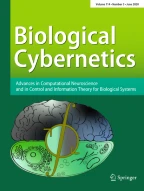Abstract
In this paper, we investigate the dynamical behaviors of a Morris–Lecar neuron model. By using bifurcation methods and numerical simulations, we examine the global structure of bifurcations of the model. Results are summarized in various two-parameter bifurcation diagrams with the stimulating current as the abscissa and the other parameter as the ordinate. We also give the one-parameter bifurcation diagrams and pay much attention to the emergence of periodic solutions and bistability. Different membrane excitability is obtained by bifurcation analysis and frequency-current curves. The alteration of the membrane properties of the Morris–Lecar neurons is discussed.
Similar content being viewed by others
References
FitzHugh R (1955) Mathematical models of threshold phenomena in the nerve membrane. Bull Math Biophys 7:252–278
Guckenheimer J, Holmes P (1983) Dynamical systems and bifurcations of vector Fields. Nonlinear oscillations. Springer, New York
Gutkin BS, Ermentrout GB (1998) Dynamics of membrane excitability determine interspike interval variability: a link between spike generation mechanisms and cortical spike train statistics. Neural Comput 10:1047–1065
Hodgkin AL (1948) The local electric changes associated with repetitive action in a non-medullated axon. J Physiol 107:165–181
Izhikevich EM (2000) Neural excitability, spiking and bursting. Int J Bifurcation Chaos 10:1171–1266
Izhikevich EM (2007) Dynamical systems in neuroscience. MIT Press, Cambridge, MA
Kepler TB, Abbott LF, Marder E (1992) Reduction of conductance-based neuron models. Biol Cybern 66:381–387
Koch C (1999) Biophysics of computation. Oxford University Press, New York
Kuznetsov YA (1998) Elements of applied bifurcation theory, 2nd edn. Springer, New York
Kuznetsov et al (2010) MATCONT is available at http://www.matcont.ugent.be
Morris C, Lecar H (1981) Voltage oscillations in the barnacle giant muscle fiber. Biophys J 35:193–213
Prescott SA, De Koninck Y (2002) Four cell types with distinctive membrane properties and morphologies in lamina I of the spinal dorsal horn of the adult rat. J Physiol 539:817–836
Prescott SA, De Koninck Y, Sejnowski TJ (2008) Biophysical basis for three distinct dynamical mechanisms of action potential initiation. PLOS Comput Biol 4:1–18
Rinzel J, Ermentrout GB (1989) Analysis of neural excitability and oscillations. In: Koch C, Segev I (eds) Methods in neuronal modeling: from Ions to networks. MIT Press, Cambridge, MA, pp 251–291
Sculptoreanu A, De Groat WC (2007) Neurokinins enhance excitability in capsaicin-responsive DRG neurons. Exp Neurol 205: 92–100
Smith PH (1995) Structural and functional differences distinguish principal from nonprincipal cells in the guinea pig MSO slice. J Neurophysiol 73:1653–1667
Tsuji S, Ueta T et al (2007) Bifurcations in two-dimensional Hindmarsh–Rose type model. Int J Bifurcation Chaos 17:985–998
Tsumoto K, Kitajima H et al (2006) Bifurcations in Morris–Lecar neuron model. Neurocomputing 69:293–316
Acknowledgments
This work was supported by the National Natural Science Foundation of China (Grant No. 11172103). The authors are grateful to the referees for their valuable suggestions, which helped us to improve the manuscript.
Author information
Authors and Affiliations
Corresponding author
Rights and permissions
About this article
Cite this article
Liu, C., Liu, X. & Liu, S. Bifurcation analysis of a Morris–Lecar neuron model. Biol Cybern 108, 75–84 (2014). https://doi.org/10.1007/s00422-013-0580-4
Received:
Accepted:
Published:
Issue Date:
DOI: https://doi.org/10.1007/s00422-013-0580-4
